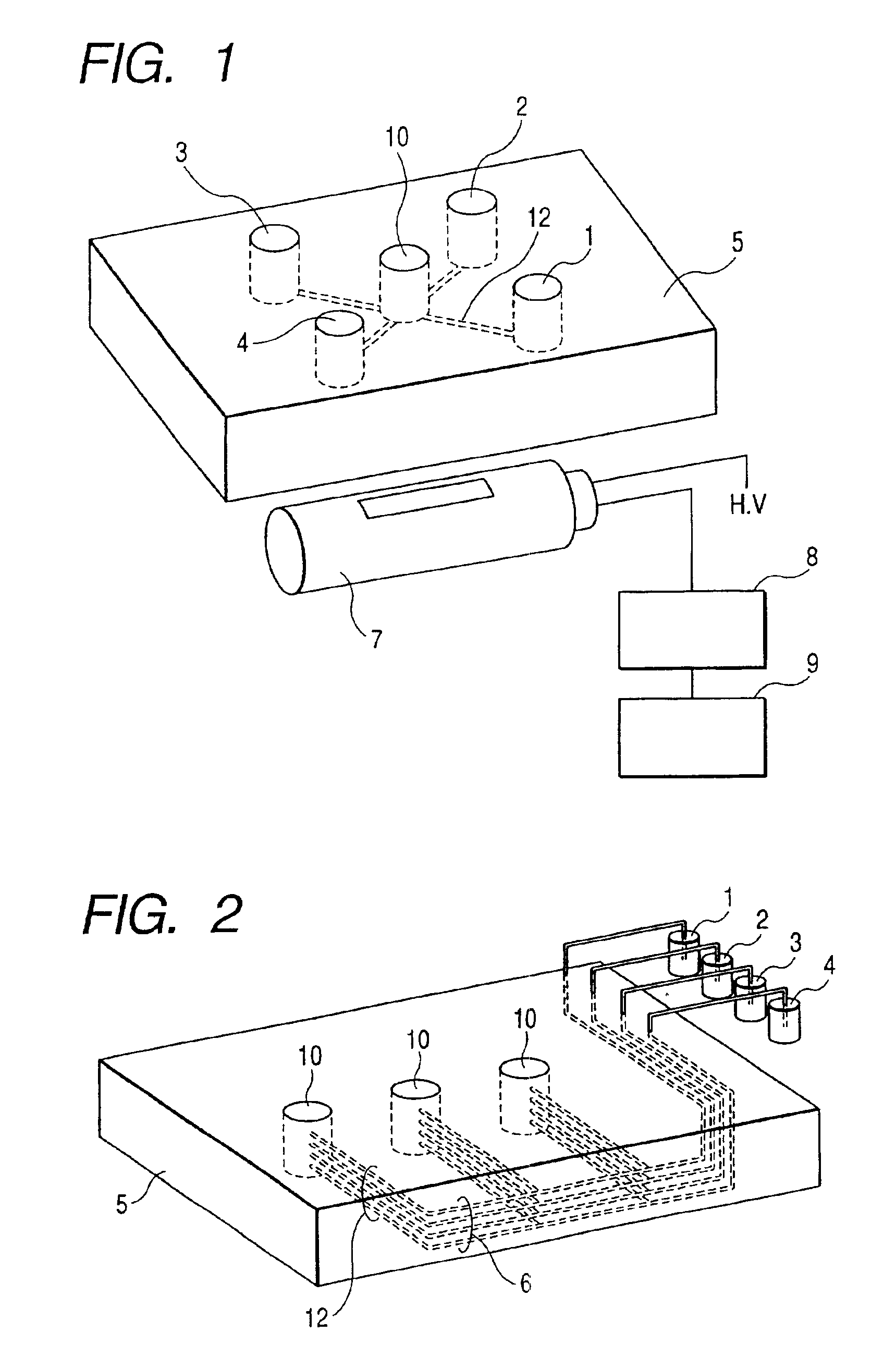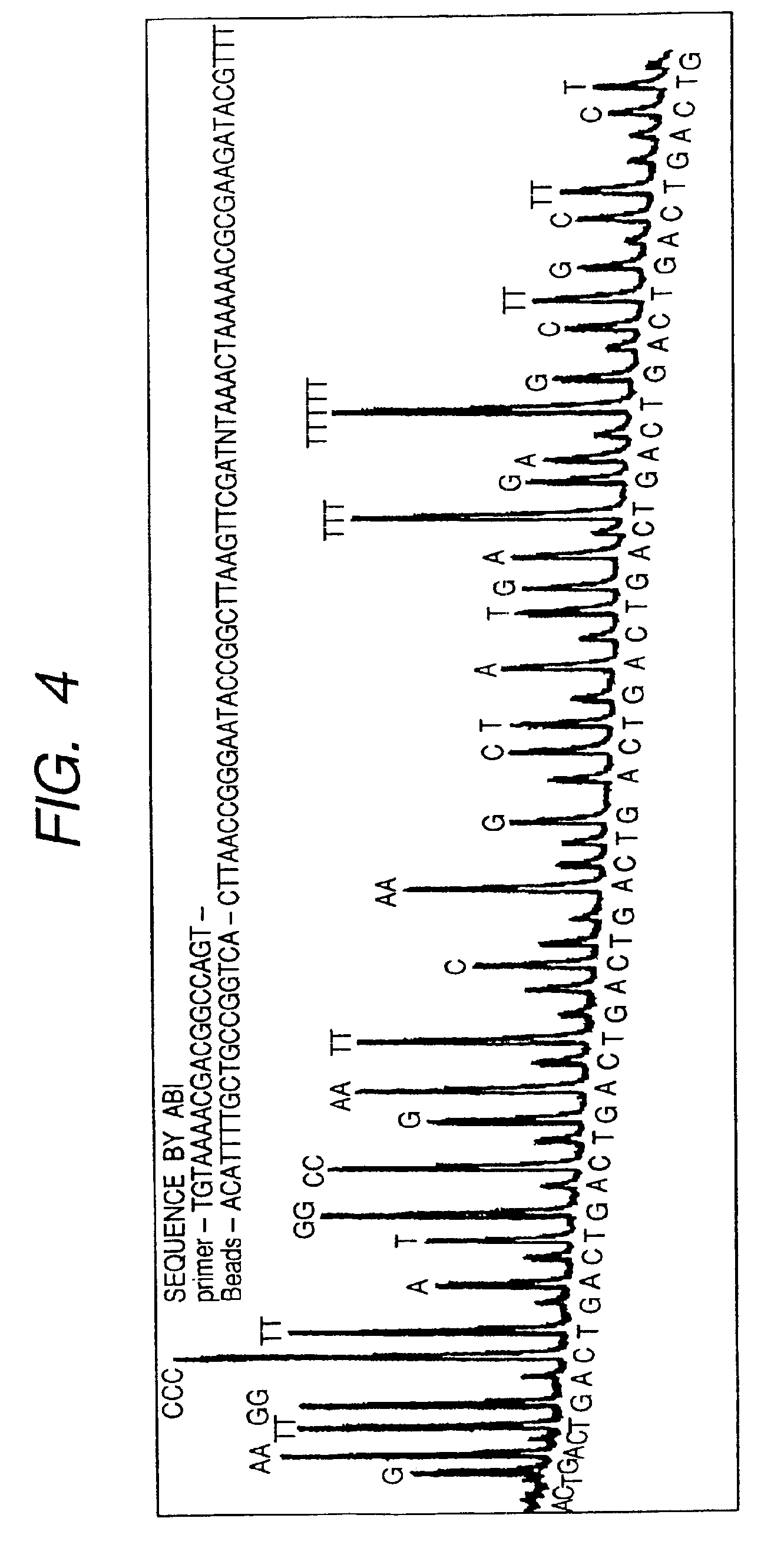DNA base sequencing system
- Summary
- Abstract
- Description
- Claims
- Application Information
AI Technical Summary
Benefits of technology
Problems solved by technology
Method used
Image
Examples
example 1
FIG. 1 shows a structure example of Example 1 according to the present invention, which is a pyrosequencing device (DNA base sequencing system) having one reaction vessel and dNTP reagent reservoirs. A reaction chamber module comprises a reaction chamber (reaction vessel) 10 and reagent reservoirs 1, 2, 3 and 4 each holding one of four kinds of dNTP, all formed on a device board 5. The reaction chamber 10 and each reservoir are connected by capillaries 12 for reagent introduction, through which dNTP from each reagent reservoir is supplied into the reaction vessel for use in the reaction. dNTP is allowed to flow into reaction chamber 10 by pressurizing the liquid surface of each reagent reservoir. It is necessary to suppress a backward flow of the reaction solution and to prevent flow of the reagents into other sites due to a slight difference in the level of liquid surface. Therefore, capillaries having an inner diameter of less than 0.1 mm or a cross section of less than 0.01 mm2 a...
example 2
FIG. 5 is a structure example of Example 2, showing one type of pyrosequencing device (DNA base sequencing system) in which dNTP is injected into a reaction vessel via capillaries from the upper part. In Example 2, reagents are injected from the upper part of the reaction chamber 10. The reaction chamber module of Example 2 is composed of the reaction vessel (reaction chamber) 10 formed on a device board 5 and a cover (reagent supply unit) 11 which is separable from the device board 5. The upper part of the reaction chamber 10 is covered with the cover 11 which is equipped with reagent-introducing narrow tubes 6 and reagent-introducing capillaries (capillaries) 12. The capillaries 12 in Example 2 have an increased inner diameter of 0.2 mm since the part of the capillaries in contact with the reaction chamber 10 is longer than that in Example 1. The conductance of the capillary having an inner diameter of 0.2 mm for the reagent solution determines the injection speed of the solution....
example 3
FIG. 7 is a structure example of Example 3 of the present invention, showing a conjugate-type reaction chamber module of a DNA sequencing system, in which a multiple number of reaction vessels and a multiple number of reagent reservoirs are installed and reagents are supplied into reaction vessels using narrow tubes formed by microprocessing or the like.
In the example of the conjugate-type reaction chamber module shown in FIG. 7, reaction reagents are supplied from the lower part of the reaction chambers 10. In the conjugate-type reaction chamber module, an upper board 14 having a multiple number of holes to be made into reaction chambers 10 are formed and the lower board 15 comprising a multiple number of reagent reservoirs 1, 2, 3, 4, 1′, 2′, 3′ and 4′ and reagent-introducing capillaries (narrow grooves) 13 are formed and conjugated such that the multiple number of reaction chambers 10 are formed by the conjugation between the upper board 14 and the lower board 15. A reagent reser...
PUM
| Property | Measurement | Unit |
|---|---|---|
| Diameter | aaaaa | aaaaa |
| Diameter | aaaaa | aaaaa |
| Diameter | aaaaa | aaaaa |
Abstract
Description
Claims
Application Information
 Login to View More
Login to View More - R&D
- Intellectual Property
- Life Sciences
- Materials
- Tech Scout
- Unparalleled Data Quality
- Higher Quality Content
- 60% Fewer Hallucinations
Browse by: Latest US Patents, China's latest patents, Technical Efficacy Thesaurus, Application Domain, Technology Topic, Popular Technical Reports.
© 2025 PatSnap. All rights reserved.Legal|Privacy policy|Modern Slavery Act Transparency Statement|Sitemap|About US| Contact US: help@patsnap.com



